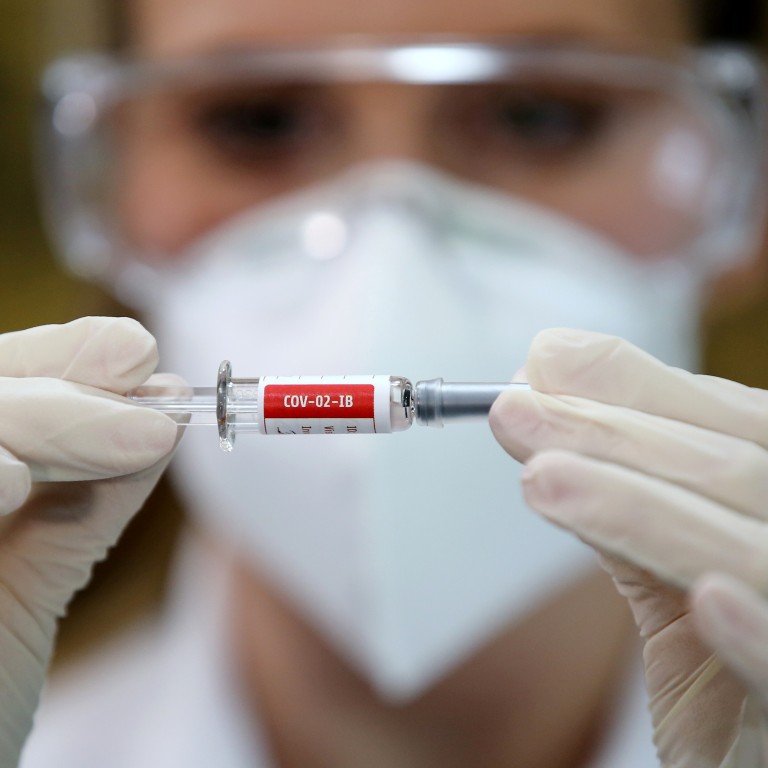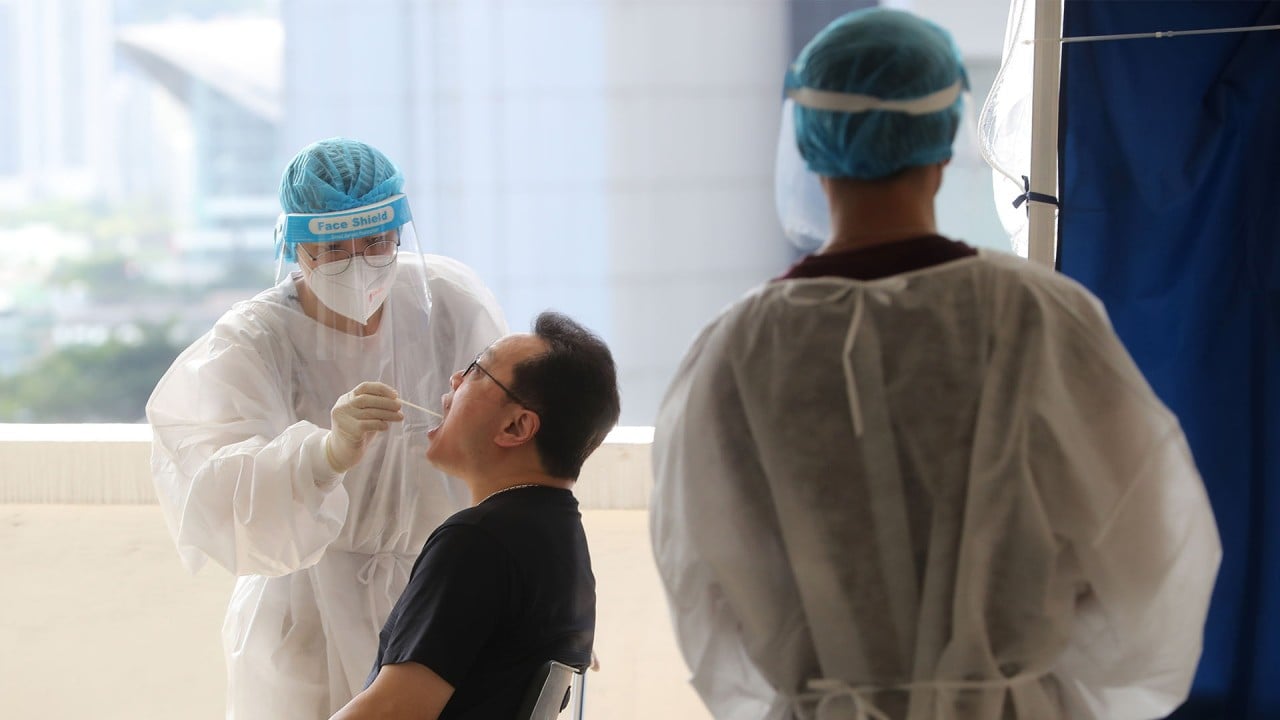
Coronavirus: Hong Kong’s fourth wave ‘could be the worst yet’ as city aims for enough Covid-19 vaccine shots to cover double city’s population
- Government reserves HK$8.4 billion for vaccine procurement as it unveils strategy for warding off potential fourth wave of coronavirus
- Ministers fear next rush of Covid-19 cases could be the worst the city has ever seen
Key points
• HK$8.4 billion set aside to procure enough vaccine shots for two times the population
• Regular testing for high-risk groups with daily capacity increased to tens of thousands
• Quarantine facilities with at least 4,000 units to be ready by the end of this year, including at Penny’s Bay, Lei Yue Mun Park and Holiday Village and hotels
• Temporary hospital next to AsiaWorld-Expo to be completed in four months
• To step up enforcement of social distancing at restaurants and pubs, police and hygiene officers to join forces this weekend
• Digital platform created to consolidate data and speed up contact tracing among government departments
Under the fight against a potential fourth wave of infections, a new round of targeted Covid-19 testing was launched on Friday with the screening of care home staff, while police would this weekend join environmental hygiene officers to enforce social-distancing curbs at restaurants and pubs.
Hong Kong to launch second round of Covid-19 testing for high-risk workers
Health minister Professor Sophia Chan Siu-chee warned the next rush of coronavirus cases in the city could be even worse than the existing one, Hong Kong’s deadliest amid the health crisis so far.
The city recorded three new infections on Friday and the death of an 81-year-old male resident of Fung Shing Nursing Home in Kwai Chung. The sources of the two local infections were traceable while the third case was imported. The tally now stood at 4,996 cases with 103 related deaths.

05:38
What started Hong Kong's third Covid-19 wave?
“The number of third wave infections is declining very slowly, with the fourth wave possibly coming in winter, which could be even more severe than the third,” Chan said.
“The measures will not eradicate the virus without the vaccine but will avoid major outbreaks in the community.”
She stressed that to stop the risk of imported cases the city could not relax cross-border controls, given the global Covid-19 outlook remained severe.
The health authorities had already planned to procure shots from different vaccine manufacturers for at least double the city’s 7.5 million population in case one of the candidates failed. The government had set aside HK$8.4 billion (US$1.07 billion) for procurement.
“Not all vaccines will materialise and be available, but if they all do, Hong Kong will have two times the vaccines we need,” a government source said. “The failure rate of vaccines being developed is very high.”
Hong Kong has joined the Covax Facility led by Gavi, a global Vaccine Alliance, the Coalition for Epidemic Preparedness Innovations and the World Health Organisation, which would cover vaccine shots for 35 per cent of the city’s population.
The Covax Facility would cost HK$461.5 million and the advanced purchase agreements from other commercial vaccine makers were estimated to be HK$5 billion, while implementation costs would reach HK$2.9 billion.
The government also announced regular voluntary Covid-19 testing for high-risk workers.
Those working at slaughterhouses, container terminals and other crucial infrastructure facilities would be entitled to the test.

Also included in the scheme were taxi drivers and workers at care homes, restaurants and wet markets, as the Post reported earlier.
From Friday, the Social Welfare Department would start testing staff from centres looking after the elderly and disabled, as well as hospices.
About 5,000 tests could be carried out each day for the high-risk groups. The overall daily testing capacity of the city had already increased to at least 10,000.
Chan said: “If community outbreaks emerge, our measures will allow us to conduct target-oriented testings and identify asymptomatic patients more swiftly.”
A digital platform to consolidate data from various government departments has been created to speed up contact tracing.
The construction of a makeshift hospital spanning 3.2 hectares next to AsiaWorld-Expo, an exhibition centre near the airport, was expected to be completed within four months, providing 800 negative pressure beds.
“We need to have these facilities ready so we can use them swiftly if a big outbreak occurs again,” Hospital Authority chief executive Dr Tony Ho Pat-sing said.
By the end of the year, health authorities also aimed to boost quarantine and isolation facilities to 4,000 units, including 2,000 at Phase Three and Four of Penny’s Bay and others at Lei Yue Mun Holiday Village, and through renting hotels.
Dr Leung Chi-chiu, a respiratory medicine specialist, said the new measures were a step in the right direction but stressed that preventing a fourth wave of infections would depend on how early health authorities could intervene to cut the transmission chain.
Leung said targeted testing among high-risk groups was not a guarantee that silent transmission could be eliminated altogether as the virus could still spread via importation or in new clusters.
“The key determinant if we have another outbreak … is if we can intervene early and scale down the outbreak by applying social-distancing measures and speed up contact tracing we will be able to contain it within a shorter period of time,” he said.
Leung also suggested using test kits that could show results within 24 hours to detect asymptomatic cases as soon as possible and to minimise the time cost for workers in high-risk occupations.
The relaxation of social-distancing restrictions continued on Friday with Ocean Park and swimming pools reopening at half capacity and pubs operating with a maximum of two customers per table until midnight, even as untraceable cases still accounted for nearly one-fifth of recent infections.
A total of 66 people in charge of eateries were prosecuted for violating social-distancing rules when the Food and Environmental Hygiene Department conducted checks at more than 6,100 restaurants between September 11 and 16.
Liberal Party lawmaker Tommy Cheung Yu-yan, who represents the catering sector, said testing would always help, especially as workers in his industry were on the front line meeting a lot of people every day.


